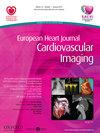Serial right ventricular assessment in patients with hypoplastic left heart syndrome patients (HLHS): a cardiovascular magnetic resonance study
引用次数: 0
Abstract
Type of funding sources: None. Patients with hypoplastic left heart syndrome (HLHS) are at risk for right ventricular (RV) dysfunction over the course of the three-stage surgical palliation with the final step being the completion of the total cavopulmonary connection (TCPC). However, less is known about RV function during follow-up after TCPC completion. We assessed RV function by analysing serial cardiovascular magnetic resonance (CMR) studies in a large cohort of HLHS patients. CMR studies from 95 HLHS patients (67 males) were retrospectively analysed. Short axis cine images were used to measure RV end systolic and end diastolic volumes and ejection fraction (RVEF). Oblique cine images showing the atria and right ventricle in a similar manner like a standard "4-chamber view" were used to measure tricuspid annular plane systolic excursion (TAPSE) and long axis strain (LAS). From the 95 patients, all had at least two and 32 patients had three CMR scans. The first scan was performed at a mean age of 4.9 ± 2.8 years, the second scan at a mean age of 9.3 ± 4 years and the third at a mean age of 14.3 ± 3.7 years. The mean values of RV end diastolic and end systolic volume indexed to body surface area (REDVi, RVESVi) as well as RV ejection fraction (RVEF) at the three time points were: 1) REDVi 92.6 ± 21.9 ml/m2, RVESVi 43 ± 15.1 ml/m2, RVEF 54.2 ± 7.1%; 2) REDVi 93.9 ± 25.6 ml/m2, RVESVi 44.6 ± 18.3 ml/m2, RVEF 53.6 ± 7.8%; 3) REDVi 110.9 ± 41.9 ml/m2, RVESVi 58.1 ± 35 ml/m2, RVEF 50.1 ± 10.1%. There was a statistically significant increase in RVEDVi and RVESVi from the first and the second scan to the third scan (p < 0.01). RVEF was lower at the time of the third scan compared to the first and second scan, but this difference was not statistically significant. TAPSE increased slightly from the first to the third scan (p < 0.05). There was no change in stroke volume and LAS from the first to the third scan. Strong correlations were found between RVEF and LAS as well as between RVEF and TAPSE (r = 0.49 and r=-0.50; p < 0.001, respectively). Serial assessment of CMR studies in HLHS patients after TCPC completion could demonstrate an increase in indexed RV volumes over time, whereas RV stroke volume, RVEF and LAS largely remain stable.左心发育不全综合征患者(HLHS)的连续右心室评估:心血管磁共振研究
资金来源类型:无。左心发育不全综合征(HLHS)患者在完成全腔室肺连接(TCPC)的三期手术缓解过程中存在右室功能障碍的风险。然而,在TCPC完成后的随访中,对RV功能的了解较少。我们通过分析大量HLHS患者的系列心血管磁共振(CMR)研究来评估右心室功能。回顾性分析95例HLHS患者(67例男性)的CMR研究。用短轴影像测量右心室收缩期末和舒张期末容积和射血分数(RVEF)。斜向电影图像显示心房和右心室类似于标准的“四室视图”,用于测量三尖瓣环平面收缩偏移(TAPSE)和长轴应变(LAS)。在95例患者中,所有患者至少进行了两次CMR扫描,32例患者进行了三次CMR扫描。首次扫描的平均年龄为4.9±2.8岁,第二次扫描的平均年龄为9.3±4岁,第三次扫描的平均年龄为14.3±3.7岁。3个时间点右心室舒张末期和收缩末期体积(以体表面积为指标)(REDVi, RVESVi)和右心室射血分数(RVEF)均值分别为:1)REDVi 92.6±21.9 ml/m2, RVESVi 43±15.1 ml/m2, RVEF 54.2±7.1%;2) REDVi 93.9±25.6 ml/m2, RVESVi 44.6±18.3 ml/m2, RVEF 53.6±7.8%;3) REDVi 110.9±41.9 ml/m2, RVESVi 58.1±35 ml/m2, RVEF 50.1±10.1%。RVEDVi和RVESVi从第一次和第二次扫描到第三次扫描有统计学意义(p < 0.01)。与第一次和第二次扫描相比,第三次扫描时的RVEF较低,但这种差异无统计学意义。从第一次扫描到第三次扫描,TAPSE略有增加(p < 0.05)。从第一次扫描到第三次扫描,卒中容量和LAS没有变化。RVEF与LAS以及RVEF与TAPSE之间存在强相关性(r = 0.49和r=-0.50;P < 0.001)。对hhs患者完成TCPC后CMR研究的系列评估显示,随着时间的推移,索引右心室容量增加,而右心室卒中容量、RVEF和LAS基本保持稳定。
本文章由计算机程序翻译,如有差异,请以英文原文为准。
求助全文
约1分钟内获得全文
求助全文

 求助内容:
求助内容: 应助结果提醒方式:
应助结果提醒方式:


